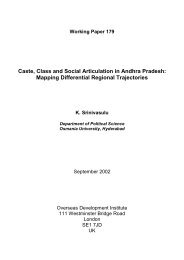Full Report - Research for Development - Department for ...
Full Report - Research for Development - Department for ...
Full Report - Research for Development - Department for ...
Create successful ePaper yourself
Turn your PDF publications into a flip-book with our unique Google optimized e-Paper software.
Synthesis results<br />
Training and audit<br />
Nine papers focused on training and audit. Several studies evaluated the impact of<br />
training and/or audit (or death review) on maternal and neonatal deaths. These<br />
facility-based quality improvement measures seemed to be associated with improved<br />
maternal health outcomes (Bugalho and Bergstrom, 1993 (-)/(-); Dumont et al., 2005<br />
(++)/(++); Dumont et al., 2006 (++)/(++); Kongnyuy et al., 2008 (+)/(+)).<br />
Audit was the most frequently reported service intervention <strong>for</strong> reducing maternal<br />
mortality. A study by Awan et al. (1989) (+)/(-) in Lahore, Pakistan, evaluated a<br />
complex intervention (staff increases, peer review and feedback), and used trend<br />
analysis with be<strong>for</strong>e-intervention and during- and post-intervention outcomes <strong>for</strong> a<br />
range of reproductive health outcomes, including IMR and MMR. They demonstrated<br />
how audits can be used to develop professional responsibility. Comprehensive audit<br />
systems with periodical checks were also found to be significant in reducing waiting<br />
times, emergency cases and ultimately maternal mortality. A pre- and post-test<br />
study in urban Angola by Strand et al. (2009) (-)/(+) specifically considered the audit<br />
of obstetric emergencies. A substantial decline in the number of maternal deaths<br />
occurred alongside the use of improved partogrammes, reduced waiting times,<br />
improved vigilance and increased awareness of the birthing process, but the study<br />
design was unable to show causality. De Muylder and Thiery (1989) (-)/(-) reported<br />
time trend analyses of rates of C-section following the introduction of guidelines <strong>for</strong><br />
the management of dystocia, previous C-section, foetal distress and breech<br />
presentation in Zimbabwe. They showed a decline in rates of C-section and maternal<br />
mortality over two years, and attributed this to implementation of the guidelines, in<br />
the absence of any new technology introduced over the same period. Bhatt (1989) (-<br />
)/(-) considered how a drop in maternal deaths from 1967-8 to 1983-4 at a teaching<br />
hospital in Baroda, India, might have been due to the initiation of medical audit and<br />
maternal death review. The paper showed a decline in maternal deaths from 43 in<br />
1967-8 to 36 in 1983-4 despite a growing case load over that period. The audit was<br />
able to highlight problems such as lack of supervision <strong>for</strong> junior staff and high-risk<br />
times when senior staff were away at weekends and holidays. In general, audit<br />
meetings appeared to be low-cost interventions to identify avoidable deaths and<br />
gaps in the human resource per<strong>for</strong>mance.<br />
A note of caution must be introduced, however, regarding the impact of audits and<br />
reviews. Although not one of our included papers, Filippi et al. (2004), based on a<br />
four-country study (Benin, Côte d'Ivoire, Ghana and Morocco), demonstrate the<br />
difficulties involved in sustaining this kind of initiative. The majority of papers in our<br />
review did not consider the sustainability of the intervention and we can only<br />
speculate that they would be sustainable due to the reported low cost in some<br />
studies.<br />
Training is the focus of an intervention in Guatemala (O’Rourke, 1995) (+)/(-). The<br />
programme's goals were to institute standards of care <strong>for</strong> obstetric and neonatal<br />
patients as well as to improve relations between hospital staff and TBAs in both rural<br />
and urban areas. Despite increasing referral and improving satisfaction, the<br />
programme did not result in a statistically significant reduction in mortality.<br />
Provider models<br />
Only one paper (de Bernis et al., 2000) (+)/(+) looked specifically at the link<br />
between service delivery and maternal mortality and morbidity in urban populations<br />
with contrasting availability of health care. This study, from Senegal, showed that<br />
an area where women were more likely to deliver in hospitals with trained midwives<br />
had lower levels of maternal mortality than an area where most women gave birth in<br />
district health centres, usually assisted by TBAs, implying that access to skilled<br />
health care is fundamental. Given that the distribution of women by socio-economic<br />
What are the effects of different models of delivery <strong>for</strong> improving maternal and infant health<br />
outcomes <strong>for</strong> poor people in urban areas in low income and lower middle income countries? 35









